Abstract
Machine learning is emerging as a powerful tool across many scientific fields, including water resource management. In Morocco, growing challenges such as climate change, population growth, and high water demand—especially in agriculture—have led researchers to apply these techniques to water-related issues. This study reviews recent research conducted in Morocco, highlighting major trends, scientific contributions, and progress in machine learning applications for hydrological challenges. Following the PRISMA framework, a systematic search was carried out in the Scopus database, resulting in 103 relevant publications affiliated with Moroccan institutions. Using NVIVO and SPSS software, key themes were identified, including water quality, groundwater management, and groundwater level prediction. The most frequently used models include Random Forest (RF), Decision Tree (DT), Support Vector Machine (SVM), and Artificial Neural Networks (ANN). This article presents a comparative analysis of nine highly cited Moroccan studies, focusing on application areas, models, parameters, and performance. Findings show a clear rise in AI-related hydrological research in Morocco, especially in water quality monitoring, smart irrigation optimization, and groundwater level forecasting.
1. Introduction
Freshwater is a fundamental element for life on Earth []. It is essential not only for humans but also for animals and plants, as highlighted by Elhassan et al. []. It plays a central role in agriculture, which alone accounts for nearly 70% of global freshwater consumption each year, according to Jamil et al. []. It is also crucial in industrial [,] and domestic sectors. In light of growing challenges such as climate change, population pressure, and the degradation of natural ecosystems, sustainable water resource management has become a major global concern [,].
In this context, emerging technologies, particularly machine learning, offer promising solutions for improving water management worldwide, as noted by Hicham et al. [] and Elhassan et al. []. Over the past two decades, these techniques have been increasingly applied in scientific research related to water issues. Since 2007, a significant rise in academic publications focusing on the use of machine learning in water resource management has been observed, as reported by El Ansari et al. [].
In Morocco, where the climate is predominantly arid and semi-arid [], water-related challenges are especially critical. This review aims to analyze how Moroccan researchers have used machine learning in this field. It traces the evolution of research in this area, identifies key domains of application and the most frequently used models, and presents a comparative overview of several studies based on geographic focus, chosen algorithms, selected parameters, and performance evaluation criteria.
2. Methodology
This review was conducted following the guidelines of the PRISMA framework (Preferred Reporting Items for Systematic Reviews and Meta-Analyses).
The bibliographic search was carried out in the Scopus database up to July 2024, using the keywords “water” and “machine learning,” with a filter applied to include only publications affiliated with Moroccan institutions. Initially, 174 references were identified. Of these, 16 were excluded due to missing data, and 22 were removed after abstract screening for being outside the study’s scope. A more thorough review led to the exclusion of 33 additional papers: 25 did not specifically focus on water resource management, and 8 did not involve the use of machine learning models. In the end, 103 publications were retained for bibliometric analysis using NVivo 12 Plus and IBM SPSS Statistics 23, with 9 of them selected for detailed textual analysis.
3. Results
3.1. Length of Papers
The statistical table (Table 1), which presents the distribution of reference types in the analyzed corpus, reveals the following breakdown:

Table 1.
Types of publications (source by SPSS).
3.2. Years of Publication
The diagram (Figure 1) illustrates the evolution of publications on the topic of water and machine learning in Morocco. The first studies were published in 2018, with two initial references. In 2020, a notable increase in the number of publications was observed, reaching nine articles. In 2023, the number of publications peaked at 39 references, with this review covering up to July 2024. This suggests that 2024 could potentially surpass 2023 in terms of publications. In summary, although this field of research is still relatively new at the national level, Moroccan researchers appear to be slightly behind, especially since the first international publications on this topic began in 2007, according to El Ansari [].
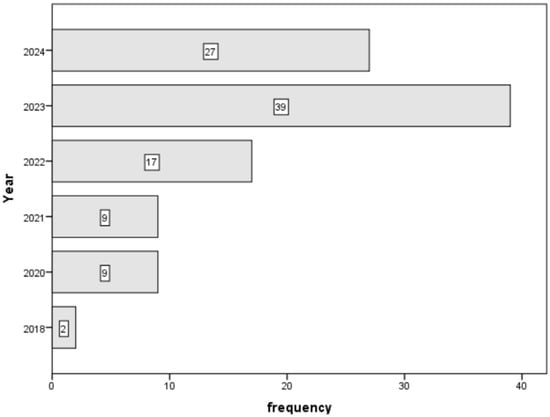
Figure 1.
Publication frequency by year.
3.3. Type of Reference by Year
This diagram (Figure 2) shows the distribution of bibliographic reference types by year.
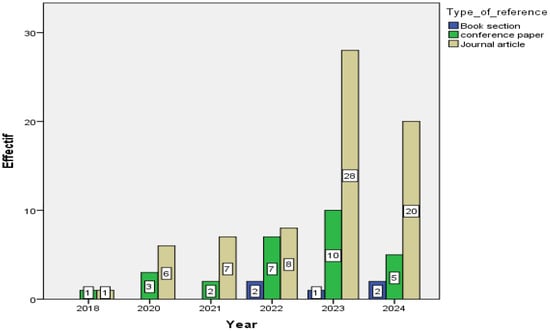
Figure 2.
Type of reference by year (source by SPSS).
3.4. The Word Cloud
A word cloud (Figure 3) visually represents the most common words associated with a specific theme, topic, or text. It is created through a textual analysis of reference summaries gathered using NVIVO. The size of each word reflects its significance or frequency within the corpus.
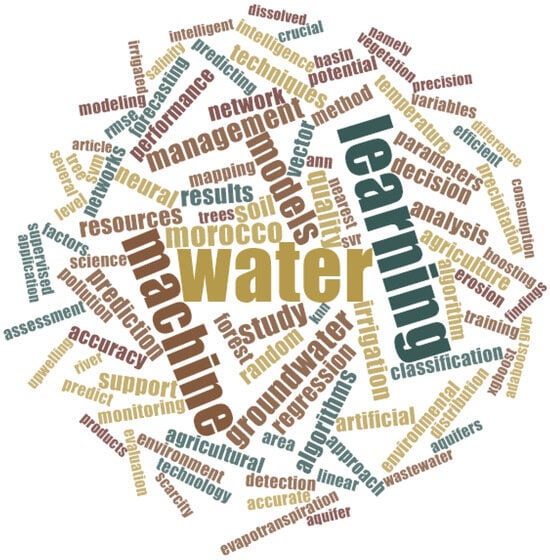
Figure 3.
The most frequently occurring terms in the corpus (Source by NVIVO).
The word cloud displays the most frequent words in a corpus of texts, with the size of each word corresponding to its frequency or importance in the dataset.
Depending on the size of the words displayed, there are three classes of words:
- Most prominent words: “water,” “learning,” and “machine” are the largest words, indicating they are the most frequently used terms in the analyzed corpus;
- Second significant terms: words like “management,” “groundwater,” “resources,” “models,” ”algorithm,“ “quality,“ “analysis,” and “Morocco” are also quite large;
- Third significant terms: Smaller, yet relevant words such as “support,” “mapping,” “artificial,” “random,” “accuracy,” and “forest” also appear. These terms likely provide context around the key concepts, such as methodologies or fields of study (machine learning, groundwater management).
3.5. Machine Learning Models Present in the Corpus
The analysis of the word cloud representing machine learning models used in the corpus highlights that the most frequently cited models, in descending order, are RF, SVM, DT, Linear Regression (LR), and ANN (Figure 4).
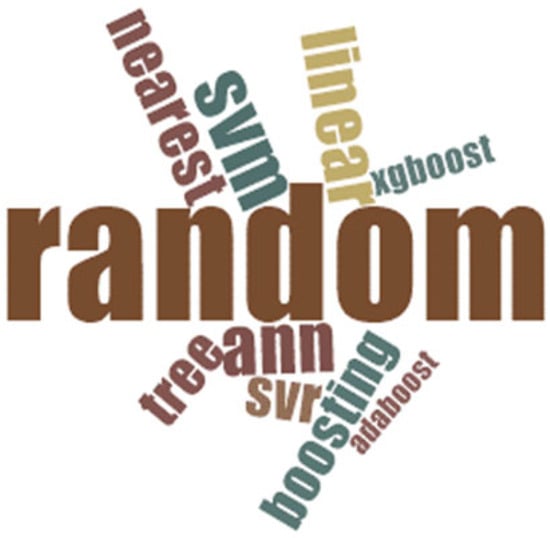
Figure 4.
Most frequently used ML models in the corpus (source by NVIVO).
The following figure (Figure 5) provides a list of machine learning models along with their frequency of mention in the text corpus and the number of files that reference each model. Here is an analysis based on the data:
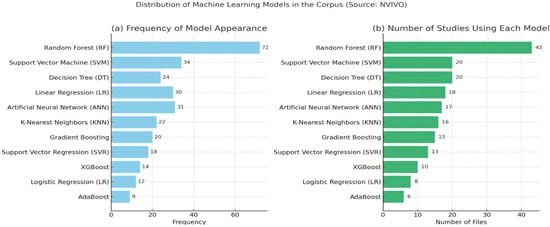
Figure 5.
Number of documents and frequency of model occurrence in the corpus.
3.6. Application Sectors of Machine Learning
After individually reviewing the abstracts, and in some cases the full reports of 103 references, the authors of this study conducted a collective discussion. This exchange made it possible to identify the main areas where machine learning (AI) is applied to water management by Moroccan researchers. These areas are illustrated in the following diagram (Figure 6).

Figure 6.
Areas of application for machine learning (source by SPSS).
4. Comparative Study of Machine Learning by Application Sector
This section presents a comparative study in table form, featuring three selected references for each of the three machine learning application areas: water quality, intelligent irrigation, and groundwater level management.
4.1. Application of Machine Learning in the Water Quality Sector
Table 2 provides an overview of several studies focused on water quality modeling conducted in diverse geographical settings, including the Berrechid aquifer [], the Sais Basin [], and various Moroccan rivers []. These studies adopt different machine learning approaches, each considered the most effective in its context, such as Random Forest (RF) [], Artificial Neural Networks (ANN) [], and Support Vector Regression (SVR) [].

Table 2.
Selected references on the application of machine learning in water quality.
The input parameters differ between studies but typically include electrical conductivity, specific ions (such as Ca2+ and Cl−), and others.
Datasets are usually split into 70–80% for training and 20–30% for testing.
To assess model performance, the most frequently used evaluation metrics are accuracy [,,], coefficient of determination (R2) [,], correlation coefficient (r) [], and root mean square error (RMSE) []. Each study identifies the most suitable model according to its specific context.
4.2. Application of Machine Learning in the Intelligent Irrigation
This table (Table 3) provides an overview of several research studies focused on smart irrigation systems using machine learning models. The analyzed works span across various study areas, including the Tadla Irrigated Perimeter (TIP) [], the Tensift basin [], and monitoring stations in Meknes and Berkane []. The machine learning techniques applied in these studies include Support Vector Machines (SVM) [], Random Forest (RF) [], XGBoost [], and Long Short-Term Memory (LSTM) networks []. These studies typically explore environmental variables such as vegetation indices, temperature, and solar radiation. The datasets are commonly split into training and testing subsets, with training portions ranging from 40% to 80% and testing from 20% to 60%.

Table 3.
Selected references on the application of machine learning in smart irrigation.
The models’ performances are evaluated using metrics such as accuracy [], kappa coefficient [], R2 [,], RMSE [], MAE, and others.
4.3. Application of Machine Learning in the Groundwater Levels
The table (Table 4) presents a summary of several studies focused on the use of machine learning models for managing groundwater levels in different geographic areas, primarily Essaouira Basin [], Rherhaya Basin (Tahnaout) [], and El-Haouz-Mejjate Region []. The models used include RF [,,] and SVM []. The input parameters vary from one study to another, ranging from topographic, hydrological, geophysical, and climatological parameters. The datasets used for training and testing the models are typically split into varying proportions, with training sets ranging from 70% to 80% and testing sets from 20% to 30%. Model performance is evaluated using several metrics, including the coefficient of determination (R2) [,], root mean square error (RMSE) [], and accuracy [].

Table 4.
Selected references on the application of machine learning in groundwater levels.
5. Discussion
This article explores the use of machine learning (ML) in monitoring of water resources in Morocco, a country facing significant population growth, climatic challenges, and increasing water needs for agriculture. The results show that the majority of publications are review articles (68%), followed by conference papers (27%) and book chapters (5%). Publications on ML and water in Morocco began in 2018, with a peak in 2023 (39 references), indicating a growing interest in this topic.
- Word Cloud: The word cloud highlights themes related to water resources, management strategies, and the application of machine learning in this field. The central term “water” emphasizes a focus on hydrology or environmental management. Words like “Morocco,” “groundwater,” and “management” point to concerns about sustainable water management in that region. Terms such as “random,” “forest,” and “artificial” suggest the use of machine learning techniques like random forest algorithms, commonly applied in environmental modeling.
- ML Models: The most commonly applied models are RF, SVM, DT, and ANN. This trend is clearly illustrated in the word cloud of ML models (Figure 4), the Figure 5 summarizing model usage frequency.
- ○
- Random Forest (RF): A supervised learning algorithm that improves prediction accuracy by combining multiple decision trees into an ensemble. This “forest” approach helps produce more reliable results by leveraging the strengths of individual models together. As noted by Moumen A (2020) [], the widespread use of this method is also highlighted by Boutracheh [], whose work examines how machine learning is applied to water resource management worldwide;
- ○
- Decision Tree (DT): a machine learning model that helps make decisions by evaluating different criteria step by step according to El Ansari [];
- ○
- Artificial Neural Network (ANN): a large, decentralized, and parallel system designed to process data, with operational characteristics similar to the biological neural networks in the human brain. [,];
- ○
- Support Vector Machine (SVM): A widely used algorithm in research because of its ability to handle both regression and classification tasks. It works by creating an optimal hyperplane that minimizes errors, improving the model’s accuracy and performance [].
- Application Sectors: The main areas where machine learning is applied in water monitoring in Morocco are water quality (25%), intelligent irrigation (19%), and groundwater level (14%).
- ○
- Water Quality: In Morocco, researchers leverage machine learning models for real-time water quality monitoring. These models help predict potential contamination by examining pollution level data, temperature, dissolved substances, and pollutant concentrations. The significance of this area is further supported by the work of Boutracheh [], which examines the application of machine learning in the field of water resources on a global scale.
- ○
- Smart Irrigation: machine learning models are used to automate and optimize the use of water resources during irrigation, with the aim of promoting smart agriculture and achieving maximum yield;
- ○
- Groundwater Levels: machine learning models are employed to map the evolution of aquifers and predict groundwater levels using topographic, hydrological, and climatic data, in order to enable effective management of groundwater resources.
6. Conclusions and Perspectives
Scientific publications on the use of machine learning for water resource management in Morocco are still limited and relatively recent compared to global research output. Nevertheless, they offer promising opportunities to improve the efficiency and sustainability of current practices. These models help optimize irrigation, forecast groundwater levels, and monitor water quality, contributing to smarter and more effective management.
Given the challenges of climate change, population growth, and urbanization, such technologies could play a vital role. It is crucial to steer research toward well-defined models tailored to Morocco’s specific context, by integrating more detailed local climate data and developing robust predictive tools.
Moreover, the integration of diverse data sources such as monitoring stations, satellite imagery, and local sensors will be vital for enhancing the precision and reliability of these models.
Finally, fostering collaboration between national and international research institutions and investing in the development of emerging technologies will be key to finding more effective solutions to Morocco’s water management challenges.
Author Contributions
Conceptualization, R.E.A. and Aniss Moumen; methodology, R.E.A., H.B., and M.E.B.; software, R.E.A., A.M.O., and A.M.; validation, J.H., J.E., and R.Y.; writing—original draft preparation, R.E.A.; writing—review and editing, A.M. and M.E.B.; visualization, R.E.A.; supervision, A.M. and A.M.O. All authors have read and agreed to the published version of the manuscript.
Funding
This research received no external funding.
Institutional Review Board Statement
Not applicable.
Informed Consent Statement
Not applicable.
Data Availability Statement
No new data were created or analyzed in this review. All data supporting the findings of this study are from previously published sources, which have been properly cited in the text.
Conflicts of Interest
The authors declare no conflict of interest.
References
- Griffiths, O.; Henderson, H.; Simpson, M. Environmental Health Practitioner Manual: (Common wealth of Australia). 2010. Available online: https://ww2.health.wa.gov.au/~/media/Files/Corporate/general-documents/Environmental-health/Aboriginal-environmental-health/Environmental-Health-Practitioner-Manual.pdf (accessed on 10 August 2021).
- Elhassan, J.; Aniss, M.; Jamal, C. Big Data Analytic Architecture for Water Resources Management: A Systematic Review. In Proceedings of the 4th Edition of International Conference on Geo-IT and Water Resources 2020, Geo-IT and Water Resources, New York, NY, USA, 11–12 March 2020. [Google Scholar] [CrossRef]
- Jamil, H.; Jamal, E.; Rissouni, Y.; El Mansouri, B.; Moumen, A.; Chao, J. Data process and water resources management in Morocco: Issues and challenges. In E3S Web of Conferences; EDP Sciences: London, UK, 2024. [Google Scholar] [CrossRef]
- Amin, M.M.; Veith, T.L.; Collick, A.S.; Karsten, H.D.; Buda, A.R. Simulating hydrological and nonpoint source pollution processes in a karst watershed: A variable source area hydrology model evaluation. Agric. Water Manag. 2017, 180, 212–223. [Google Scholar] [CrossRef]
- Westall, F.; Brack, A. The importance of water for life. Space Sci. Rev. 2018, 214, 50. [Google Scholar] [CrossRef]
- Alabjah, B.; Amraoui, F.; Chibout, M.M.; Slimani, M. Assessment of saltwater contamination extent in the coastal aquifers of Chaouia (Morocco) using the electric recognition. J. Hydrol. 2018, 566, 363–376. [Google Scholar] [CrossRef]
- El Asri, H.; Larabi, A.; Faouzi, M. Climate change projections in the Ghis-Nekkor region of Morocco and potential impact on groundwater recharge. Theor. Appl. Clim. 2019, 138, 713–727. [Google Scholar] [CrossRef]
- Hicham, J.; Aniss, M.; Bouabid, M. Moroccan Water Information System: Exploratory study System Literature Review. In Proceedings of the 4th Edition of International Conference on Geo-IT and Water Resources 2020, Geo-IT and Water Resources, New York, NY, USA, 11–12 March 2020. [Google Scholar] [CrossRef]
- Jamal, E.; Rissouni, Y.; Jamil, H.; El Ansari, R.; El Mansouri, B.; Chao, J.; Moumen, A. Big data analytics for the moroccan water actors: Towards an adoption model. In E3S Web of Conferences; EDP Sciences: London, UK, 2024. [Google Scholar] [CrossRef]
- El Ansari, R.; El Bouhadioui, M.; Aboutafail, M.O.; Mejjad, N.; Jamil, H.; Jamal, E.; Rissouni, Y.; Zouiten, M.; Boutracheh, H.; Moumen, A. A review of Machine learning models and parameters for groundwater issues. In Proceedings of the 6th International Conference on Networking, Intelligent Systems and Security, NISS 2023, Larache, Morocco, 24–26 May 2023; Polydisciplinary Faculty LaracheLarache: Larache, Morocco, 2023. Code 194645. [Google Scholar]
- Taylor, R.G.; Scanlon, B.; Döll, P.; Rodell, M.; Van Beek, R.; Wada, Y.; Longuevergne, L.; Leblanc, M.; Famiglietti, J.S.; Edmunds, M.; et al. Ground water and climate change. Nat. Clim. Change 2013, 3, 322–329. [Google Scholar] [CrossRef]
- Moukhliss, M.; Taleb, A.; Souabi, S.; Ouallali, A.; Spalevic, V. Groundwater quality forecasting using machine learning algorithms: Case study berrechid aquifer, central morocco. J. Agricult. For. 2022, 68, 35–56. [Google Scholar] [CrossRef]
- Jaddi, H.; El-Hmaidi, A.; Ousmana, H.; Berrada, M.; Aouragh, M.H.; Iallamen, Z.; Kasse, Z.; El Ouali, A.; Boufala, M.; Ragragui, H.; et al. Predicting Nitrate Levels in the Saïss Water Table: A Comparative Study of Machine Learning Methods. In Proceedings of the 2nd Edition of the International Conference on Natural Resources and Sustainable Development, RENA 2023, Fes, Morocco, 9–11 November 2023; FST, USMBAFez: Fes, Morocco, 2023. Code 200573. [Google Scholar]
- El Morabet, R.; Barhazi, L.; Bouhafa, S.; Dahim, M.A.; Khan, R.A.; Khan, N.A. Geospatial distribution and machine learning algorithms for assessing water quality in surface water bodies of Morocco. Sci. Rep. 2023, 13, 20599. [Google Scholar] [CrossRef] [PubMed]
- Ouzemou, J.-E.; El Harti, A.; Lhissou, R.; El Moujahid, A.; Bouch, N.; El Ouazzani, R.; Bachaoui, E.M.; El Ghmari, A. Crop type mapping from pansharpened Landsat 8 NDVI data: A case of a highly fragmented and intensive agricultural system. Remote Sens. Appl. Soc. Environ. 2018, 11, 94–103. [Google Scholar] [CrossRef]
- Kaissi, O.; Belaqziz, S.; Kharrou, M.H.; Erraki, S.; El Hachimi, C.; Amazirh, A.; Chehbouni, A. Advanced learning models for estimating the spatio-temporal variability of reference evapotranspiration using in-situ and ERA5-Land reanalysis data. Model. Earth Syst. Environ. 2023, 10, 1915–1939. [Google Scholar] [CrossRef]
- Ba-Ichou, A.; Waga, A.; Bekri, A.; Benhlima, S. Estimated Daily Reference Evapotranspiration Using Machine Learning and Deep Learning Based on Various Combinations of Meteorological Data. In Proceedings of the International Conference on Advanced Intelligent Systems for Sustainable Development, AI2SD 2022, Rabat, Morocco, 22–27 May 2022. Code 296119. [Google Scholar]
- Rafik, A.; Brahim, Y.A.; Amazirh, A.; Ouarani, M.; Bargam, B.; Ouatiki, H.; Bouslihim, Y.; Bouchaou, L.; Chehbouni, A. Groundwater level forecasting in a data-scarce region through remote sensing data downscaling, hydrological modeling, and machine learning: A case study from Morocco. J. Hydrol. Reg. Stud. 2023, 50, 101569. [Google Scholar] [CrossRef]
- Jadoud, M.; El Achheb, A.; Laftouhi, N.; Khouz, A.; Eloudi, H.; El Bchari, F.; Rachidi, S.; Bougadir, B.; Saouab, T. Assessment of Groundwater Potential in a Mountainous Area Using Machine Learning and GIS, Rherhaya Basin, High Atlas, Morocco. Iraqi Geol. J. 2023, 56, 288–306. [Google Scholar] [CrossRef]
- El Mezouary, L.; Hadri, A.; Kharrou, M.H.; Fakir, Y.; Elfarchouni, A.; Bouchaou, L.; Chehbouni, A. Machine Learning and Deep Learning Guided Assessment of Groundwater Reservoir Hydrodynamic Parameters: A Case Study of The El Haouz Aquifer. In Proceedings of the 4th International GIRE3D Congress on Participatory and Integrated Management of Water Resources in Arid Zones, GIRE3D 2023, Laayoune, Morocco, 23–25 November 2023. Code 197652. [Google Scholar]
- Moumen, A.; Bouchama, E.H.; Idirissi, Y.E.B.E. Data mining techniques for employability: Systematic literature review. In Proceedings of the 2020 IEEE 2nd International Conference on Electronics, Control, Optimization, Kenitra, Morocco, 2–3 December 2020. [Google Scholar]
- Boutracheh, H.; Mejjad, N.; El Bouhadioui, M.; Moumen, A. Water Research in the Age of AI: A Bibliometric Heuristic Analysis for Trends and Opportunities. In GIS, Applied Computing and Data Science for Water Management; Rebai, N., Moumen, A., El Bouhaddioui, M., Eds.; GIRE3D 2024. Lecture Notes in Geoinformation and Cartography; Springer: Cham, Switzerland, 2024. [Google Scholar] [CrossRef]
- El Ansari, R.; El Bouhadioui, M.; Boutracheh, H.; Moumen, A. Machine Learning for Water Resources in Morocco: Rapid Review. In The International Conference on Artificial Intelligence and Smart Environment; Springer Nature: Cham, Switzerland, 2025. [Google Scholar] [CrossRef]
- Momenzadeh, L.; Zomorodian, A.; Mowla, D. Experimental and theoretical investigation of shelled corn drying in a microwave-assisted fluidized bed dryer using Artificial Neural Network. Food Bioprod. Process. 2011, 89, 15–21. [Google Scholar] [CrossRef]
Disclaimer/Publisher’s Note: The statements, opinions and data contained in all publications are solely those of the individual author(s) and contributor(s) and not of MDPI and/or the editor(s). MDPI and/or the editor(s) disclaim responsibility for any injury to people or property resulting from any ideas, methods, instructions or products referred to in the content. |
© 2025 by the authors. Licensee MDPI, Basel, Switzerland. This article is an open access article distributed under the terms and conditions of the Creative Commons Attribution (CC BY) license (https://creativecommons.org/licenses/by/4.0/).